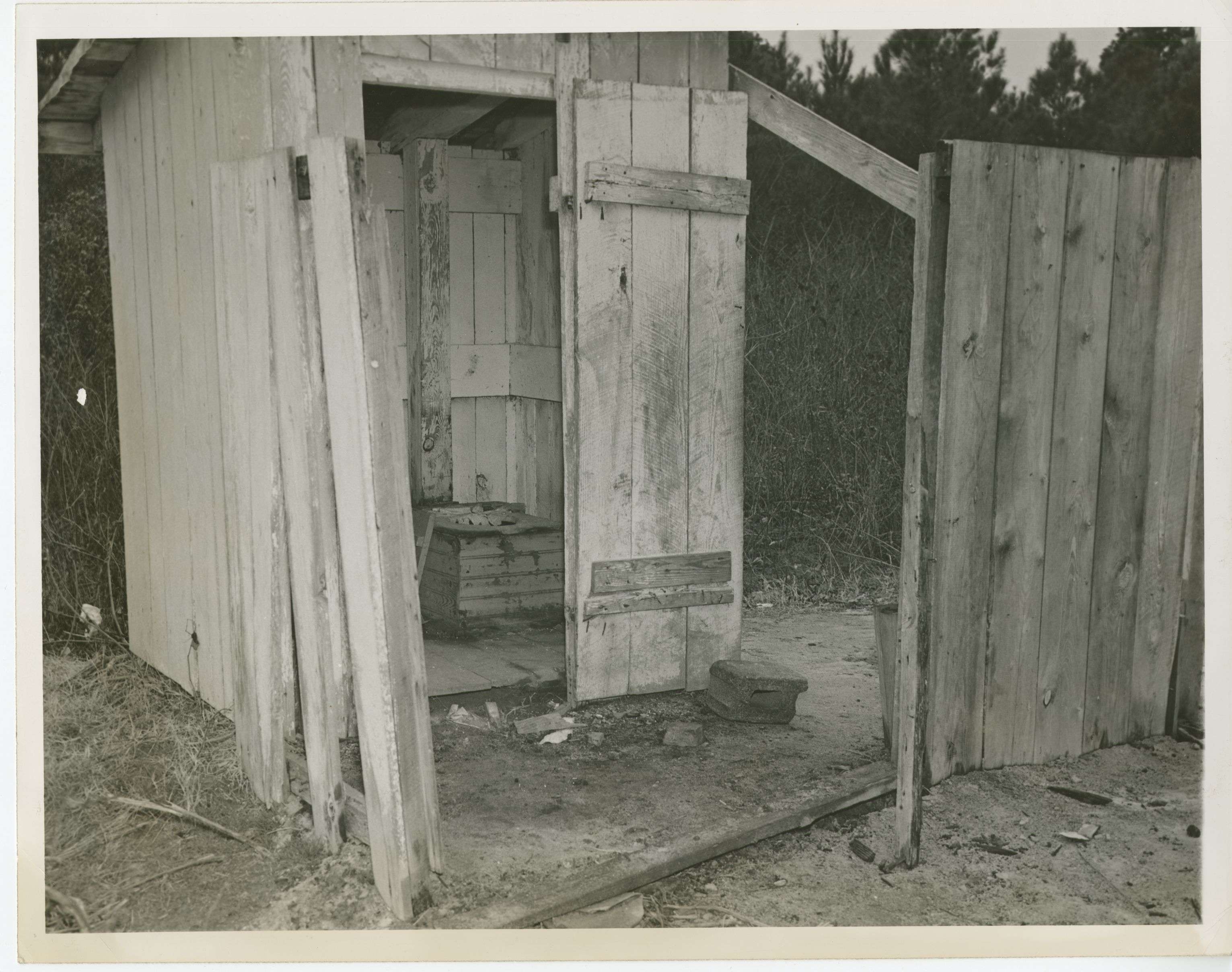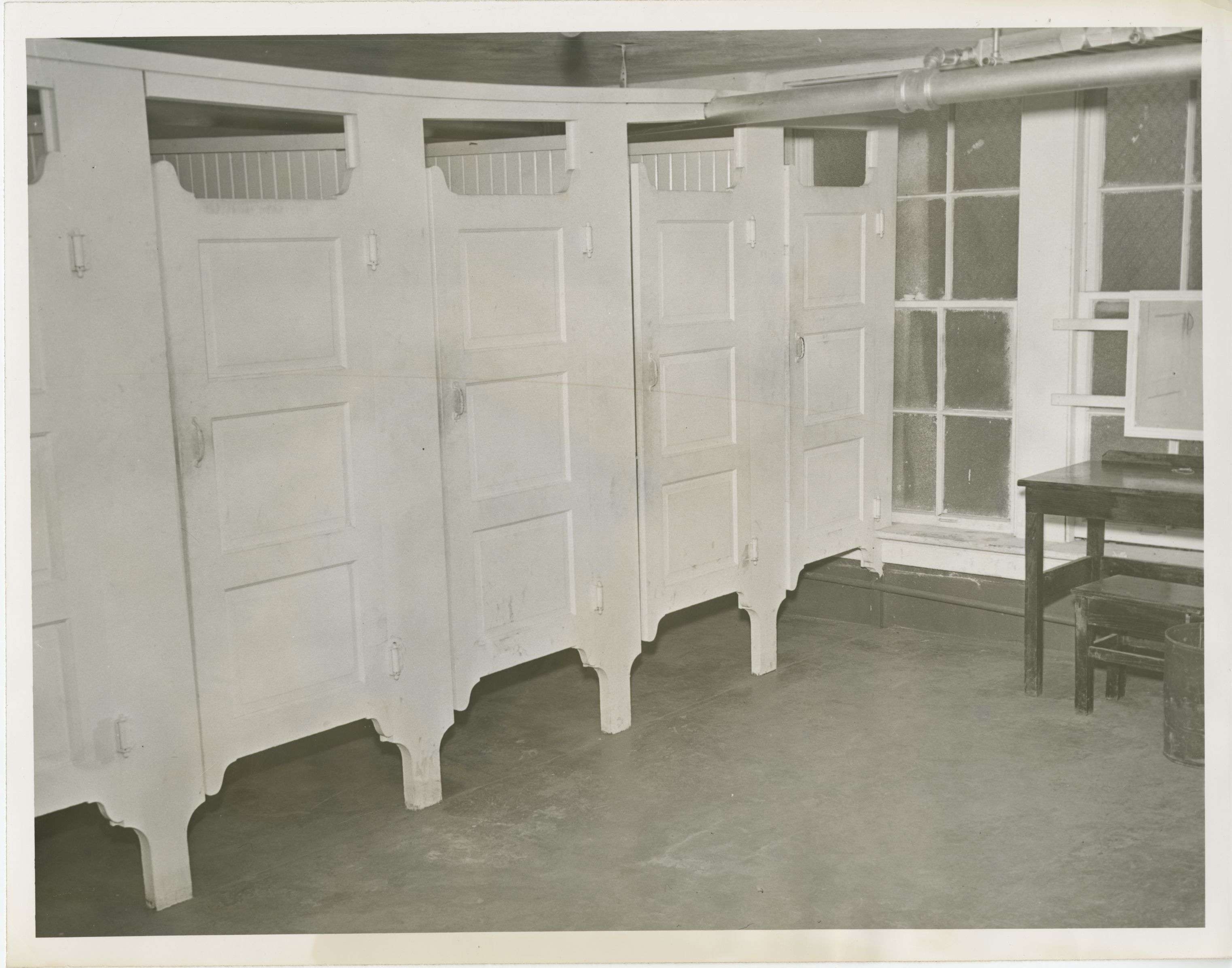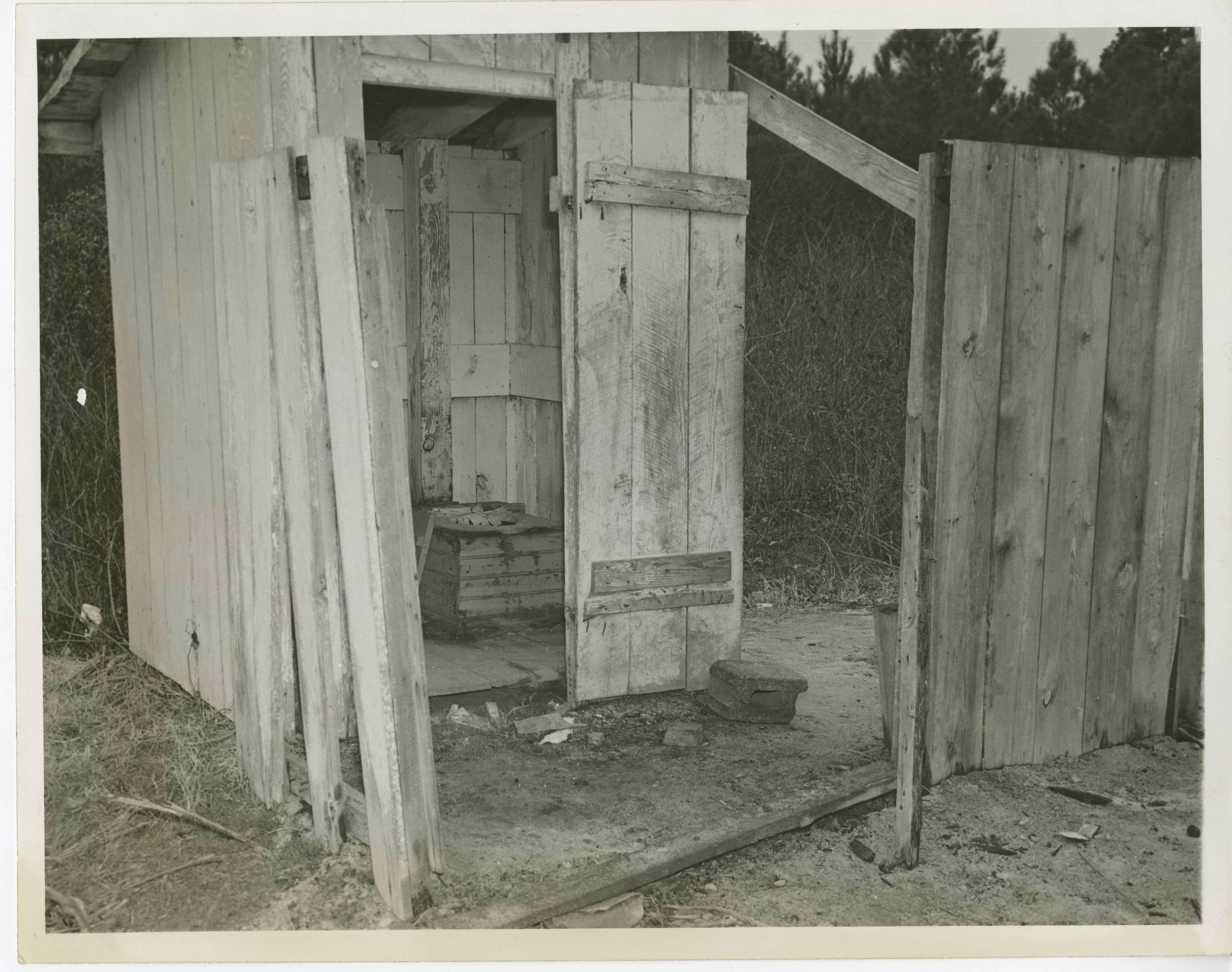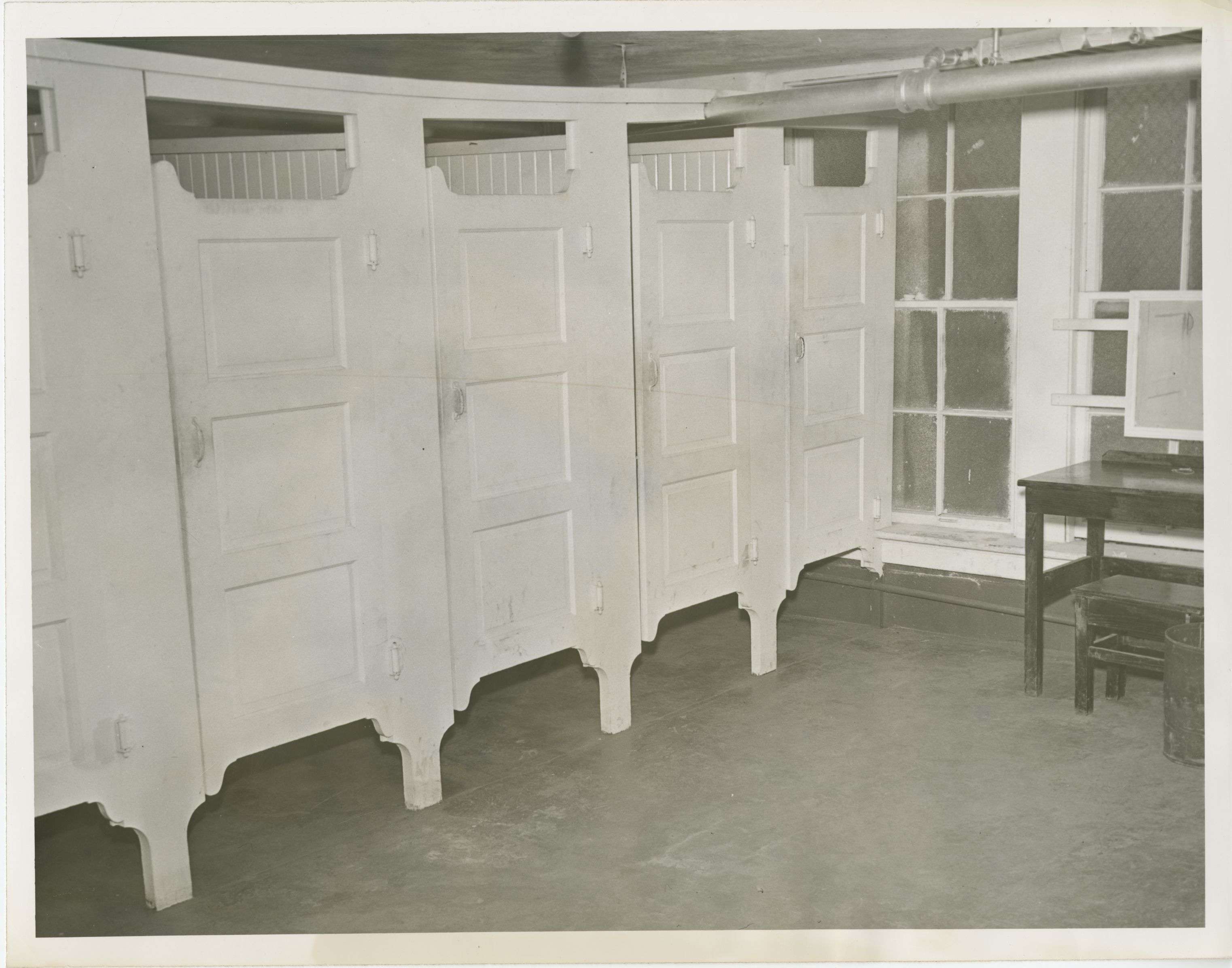Compare and Contrast: School Photographs
Focusing on Details: Compare and Contrast
All documents and text associated with this activity are printed below, followed by a worksheet for student responses.Introduction
Carefully examine each photograph below. Answer the questions underneath about the first photograph. Then click on the second photograph and answer the questions for that one.Next, compare and contrast the photos. What major differences do you see? How do you think these images relate to one another?
Name:
Class:
Class:
Worksheet
Compare and Contrast: School Photographs
Focusing on Details: Compare and Contrast
Examine the documents included in this activity and write your response in the space provided.

Meet the photo.
Quickly scan the photo. What do you notice first?
Observe its parts.
List the objects you see.
Write one sentence summarizing this photo.
Try to make sense of it.
Why do you think this photo was taken?
Your Response
1
Activity Element
View of the Boys Bathroom at Gloucester Training School

2
Activity Element
View of the Girls Bathroom at Botetourt High School

Conclusion
Compare and Contrast: School Photographs
Focusing on Details: Compare and Contrast
Answer the following:These photographs were taken in 1948 at two different schools – one for Black students, and one for White students – in Gloucester County, Virginia. What do they tell you about the equality of educational facilities provided to White and Black students?
Learn more:
The photos were used in the court case Alice Lorraine Ashley v. School Board of Gloucester County. It was one of several cases that lawyers from the Virginia chapter of the National Association for the Advancement of Colored People (NAACP) brought to U.S. District Courts across Virginia to attempt to equalize educational opportunities for Black and White students.
The plaintiffs (the ones who claimed discrimination and filed suit) entered these photograph as evidence in the case to show the unequal facilities at schools. The first image, submitted as Exhibit No. 42, shows the boys bathroom stall at the Gloucester Training High School (the school for Black students). It's a single stall located outside with no running water. The second image, Exhibit No. 28, shows a girls bathroom at Botetourt High School (the school for White students) with at least five private indoor stalls, a small vanity mirror, and running water.
Botetourt had central heating, central plumbing, and smaller class sizes. Gloucester Training School had outdoor bathrooms, no central heat, and overcrowded classrooms. The school district spent significantly more money in the White school. The average annual cost per student at Botetourt was $81.63, versus $51.49 at Gloucester Training High School.
Cases like Alice Lorraine Ashley v. School Board of Gloucester County were part of a national campaign by the NAACP – called the "equalization strategy" – which tried to convince White Americans that it cost too much for school districts to maintain separate and actually equal schools (since they had to pay for double the schools). The judge in the case ruled that the school district was discriminating against Black students and teachers, and that school officials needed to make the schools equal. But he emphasized that the court wouldn't be able to enforce the ruling, demonstrating the shortcomings of the NAACP’s equalization strategy. So the schools remained separate and unequal.
After 1950, the NAACP abandoned the equalization strategy and filed lawsuits directly challenging the constitutionality of the "separate but equal" doctrine. One such case was Dorothy E. Davis, et al. v. County School Board of Prince Edward County, Virginia, and that became one of the five cases combined into Brown v. Board of Education that ruled segregation in schools unconstitutional in 1954.
Your Response
Document
View of the Boys Bathroom at Gloucester Training School
1948
This photograph comes from the court case Alice Lorraine Ashley v. School Board of Gloucester County. It was one of several cases that lawyers from the Virginia chapter of the National Association for the Advancement of Colored People (NAACP) brought to U.S. District Courts across Virginia to attempt to equalize educational opportunities for Black and white students.
The plaintiffs entered this photograph as evidence (Exhibit No. 42) in the case to show the unequal facilities at schools for white and Black students in Gloucester County, Virginia. This image shows the boys bathroom – a single stall located outside with no running water – at Gloucester Training High School, the school for Black students. At Botetourt High School, a white school, the girls bathroom had at least five private indoor stalls, a small vanity mirror, and running water.
Botetourt had central heating, central plumbing, and smaller classroom sizes. Gloucester Training School had outdoor bathrooms, no central heat, and overcrowded classrooms. The school district spent significantly more money in the white school than they did in the Black school. The average annual cost per student at Botetourt was $81.63, versus $51.49 at Gloucester Training High School.
Judge Charles Sterling Hutcheson, U.S. District Court Judge for the Eastern District of Virginia, ruled that the school district was discriminating against Black students and teachers and that school officials needed to equalize the schools. Though, he emphasized that the court would not be enforcing the ruling.
Cases like Alice Lorraine Ashley v. School Board of Gloucester County contributed to the NAACP’s larger national campaign – the equalization strategy – which aimed to erode white support for segregated schools by demonstrating the financial cost of funding separate but equal schools for both Black and white students.
Judge Hutcheson’s ruling demonstrated the shortcomings of the NAACP’s equalization strategy, however. He recognized that the school district was discriminating against Black students and teachers but offered no solution or path forward to equity. He articulated the NAACP’s thesis that fulfilling the "separate but equal" doctrine would make it too costly for school districts to maintain separate and equal facilities, but the toothless ruling left it up to the school district to decide how to equalize.
After 1950, the NAACP abandoned the equalization strategy and filed lawsuits directly challenging the constitutionality of the "separate but equal" doctrine. One such case was Dorothy E. Davis, et al. v. County School Board of Prince Edward County, Virginia, one of the five cases combined into Brown v. Board of Education that ruled segregation in schools unconstitutional.
The plaintiffs entered this photograph as evidence (Exhibit No. 42) in the case to show the unequal facilities at schools for white and Black students in Gloucester County, Virginia. This image shows the boys bathroom – a single stall located outside with no running water – at Gloucester Training High School, the school for Black students. At Botetourt High School, a white school, the girls bathroom had at least five private indoor stalls, a small vanity mirror, and running water.
Botetourt had central heating, central plumbing, and smaller classroom sizes. Gloucester Training School had outdoor bathrooms, no central heat, and overcrowded classrooms. The school district spent significantly more money in the white school than they did in the Black school. The average annual cost per student at Botetourt was $81.63, versus $51.49 at Gloucester Training High School.
Judge Charles Sterling Hutcheson, U.S. District Court Judge for the Eastern District of Virginia, ruled that the school district was discriminating against Black students and teachers and that school officials needed to equalize the schools. Though, he emphasized that the court would not be enforcing the ruling.
Cases like Alice Lorraine Ashley v. School Board of Gloucester County contributed to the NAACP’s larger national campaign – the equalization strategy – which aimed to erode white support for segregated schools by demonstrating the financial cost of funding separate but equal schools for both Black and white students.
Judge Hutcheson’s ruling demonstrated the shortcomings of the NAACP’s equalization strategy, however. He recognized that the school district was discriminating against Black students and teachers but offered no solution or path forward to equity. He articulated the NAACP’s thesis that fulfilling the "separate but equal" doctrine would make it too costly for school districts to maintain separate and equal facilities, but the toothless ruling left it up to the school district to decide how to equalize.
After 1950, the NAACP abandoned the equalization strategy and filed lawsuits directly challenging the constitutionality of the "separate but equal" doctrine. One such case was Dorothy E. Davis, et al. v. County School Board of Prince Edward County, Virginia, one of the five cases combined into Brown v. Board of Education that ruled segregation in schools unconstitutional.
This primary source comes from the Records of District Courts of the United States.
National Archives Identifier: 159139420
Full Citation: View of the Boys Bathroom at Gloucester Training School; 1948; Civil Action No. 174; Alice Lorraine Ashley, et al. v. School Board of Gloucester Co. and J. Walter Kenny, Division Superintendent; Civil Case Files, 1941 - 12/31/1998; Records of District Courts of the United States, ; National Archives at Philadelphia, Philadelphia, PA. [Online Version, https://docsteach.org/documents/document/boys-bathroom-gloucester-training-school, April 19, 2024]View of the Boys Bathroom at Gloucester Training School
Page 1

Document
View of the Girls Bathroom at Botetourt High School
1948
This photograph comes from the court case Alice Lorraine Ashley v. School Board of Gloucester County. It was one of several cases that lawyers from the Virginia chapter of the National Association for the Advancement of Colored People (NAACP) brought to U.S. District Courts across Virginia to attempt to equalize educational opportunities for Black and white students.
The plaintiffs entered this photograph as evidence (Exhibit No. 28) in the case to show the unequal facilities at schools for white and Black students in Gloucester County, Virginia. This image shows a girls bathroom at Botetourt High School, a white school, with at least five private indoor stalls, a small vanity mirror, and running water. At the Gloucester Training High School, the school for Black students, the boys bathroom was a single stall located outside with no running water.
Botetourt had central heating, central plumbing, and smaller classroom sizes. Gloucester Training School had outdoor bathrooms, no central heat, and overcrowded classrooms. The school district spent significantly more money in the white school than they did in the Black school. The average annual cost per student at Botetourt was $81.63, versus $51.49 at Gloucester Training High School.
Judge Charles Sterling Hutcheson, U.S. District Court Judge for the Eastern District of Virginia, ruled that the school district was discriminating against Black students and teachers and that school officials needed to equalize the schools. Though, he emphasized that the court would not be enforcing the ruling.
Cases like Alice Lorraine Ashley v. School Board of Gloucester County contributed to the NAACP’s larger national campaign – the equalization strategy – which aimed to erode white support for segregated schools by demonstrating the financial cost of funding separate but equal schools for both Black and white students.
Judge Hutcheson’s ruling demonstrated the shortcomings of the NAACP’s equalization strategy, however. He recognized that the school district was discriminating against Black students and teachers but offered no solution or path forward to equity. He articulated the NAACP’s thesis that fulfilling the "separate but equal" doctrine would make it too costly for school districts to maintain separate and equal facilities, but the toothless ruling left it up to the school district to decide how to equalize.
After 1950, the NAACP abandoned the equalization strategy and filed lawsuits directly challenging the constitutionality of the "separate but equal" doctrine. One such case was Dorothy E. Davis, et al. v. County School Board of Prince Edward County, Virginia, one of the five cases combined into Brown v. Board of Education that ruled segregation in schools unconstitutional.
The plaintiffs entered this photograph as evidence (Exhibit No. 28) in the case to show the unequal facilities at schools for white and Black students in Gloucester County, Virginia. This image shows a girls bathroom at Botetourt High School, a white school, with at least five private indoor stalls, a small vanity mirror, and running water. At the Gloucester Training High School, the school for Black students, the boys bathroom was a single stall located outside with no running water.
Botetourt had central heating, central plumbing, and smaller classroom sizes. Gloucester Training School had outdoor bathrooms, no central heat, and overcrowded classrooms. The school district spent significantly more money in the white school than they did in the Black school. The average annual cost per student at Botetourt was $81.63, versus $51.49 at Gloucester Training High School.
Judge Charles Sterling Hutcheson, U.S. District Court Judge for the Eastern District of Virginia, ruled that the school district was discriminating against Black students and teachers and that school officials needed to equalize the schools. Though, he emphasized that the court would not be enforcing the ruling.
Cases like Alice Lorraine Ashley v. School Board of Gloucester County contributed to the NAACP’s larger national campaign – the equalization strategy – which aimed to erode white support for segregated schools by demonstrating the financial cost of funding separate but equal schools for both Black and white students.
Judge Hutcheson’s ruling demonstrated the shortcomings of the NAACP’s equalization strategy, however. He recognized that the school district was discriminating against Black students and teachers but offered no solution or path forward to equity. He articulated the NAACP’s thesis that fulfilling the "separate but equal" doctrine would make it too costly for school districts to maintain separate and equal facilities, but the toothless ruling left it up to the school district to decide how to equalize.
After 1950, the NAACP abandoned the equalization strategy and filed lawsuits directly challenging the constitutionality of the "separate but equal" doctrine. One such case was Dorothy E. Davis, et al. v. County School Board of Prince Edward County, Virginia, one of the five cases combined into Brown v. Board of Education that ruled segregation in schools unconstitutional.
This primary source comes from the Records of District Courts of the United States.
National Archives Identifier: 159139394
Full Citation: View of the Girls Bathroom at Botetourt High School; 1948; Civil Action No. 174; Alice Lorraine Ashley, et al. v. School Board of Gloucester Co. and J. Walter Kenny, Division Superintendent; Civil Case Files, 1941 - 12/31/1998; Records of District Courts of the United States, ; National Archives at Philadelphia, Philadelphia, PA. [Online Version, https://docsteach.org/documents/document/botetourt-girls-bathroom, April 19, 2024]View of the Girls Bathroom at Botetourt High School
Page 1

